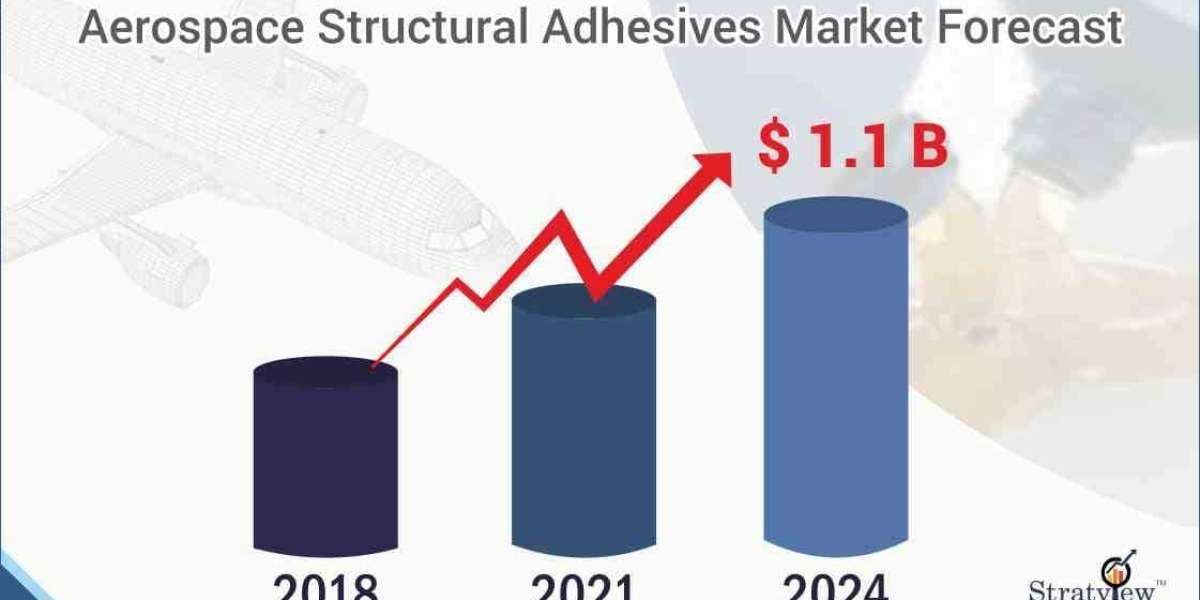Stratview Research has published a new report titled “Aerospace Structural Adhesives Market” which is segmented by Aircraft Type (Commercial Aircraft, Regional Aircraft, General Aviation, Helicopter, Military Aircraft, and UAV), by Adhesive Type (Film Adhesives, Paste Adhesives, Primers, Mold Release, and Syntactic, Core Fill, and Abradable), by Resin Type (Epoxy, BMI, and Others), by Application Type (Composite Metal Bonding and Repair, Surface Preparation, Protection, and LSP, Potting and Edge Fill, and Others), by Structure Type (Interiors, Airframe, Engine, and Others) and by Region (North America, Europe, Asia-Pacific, and Rest of the World).
As per the study, the market is projected to grow at a healthy CAGR over the next five years to reach US$ 1.07 billion in 2024.
Adhesives are gradually becoming the choice of materials in the aerospace industry, propelled by several factors including rising commercial and regional aircraft deliveries, increasing next-generation aircraft programs (B787 and A350XWB), increasing composites content, and a gradual shift from the mechanical fasteners to structural adhesives.
Report Highlights
This report covers comprehensive data on emerging trends, market drivers, growth opportunities, and restraints that can affect the market dynamics of the industry. It provides a thorough analysis of the market segments which include products, applications, and competitor analysis.
The market is bifurcated into various segments. Below given is the segment-wise analysis -
By Aircraft Type
The market is segmented based on the aircraft type as commercial aircraft, regional aircraft, general aviation, helicopter, military aircraft, and UAV.
Commercial aircraft is likely to remain the largest segment of the market during the forecast period. Increasing production rates of the key programs, such as B737 and A320 family; market entry of new players, such as COMAC and Irkut; and introduction of variants of existing and upcoming aircraft programs, such as B737 max, A320neo, and COMAC C919, are likely to create a strong demand for structural adhesives in the commercial aircraft segment.
By Resin Type
The market is segmented as epoxy, BMI, and Others.
Epoxy is likely to remain the most dominant resin system in the market over the next five years, whereas BMI is likely to witness the highest growth over the next five years.
Epoxy adhesives are widely used in the aerospace industry, owing to their excellent adhesion to metals as well as substrates such as thermoset plastics or composites. They provide exceptional durability, and superior temperature resistance with low shrinkage, and do not produce volatiles during the curing process.
By Structure Type
The market is segmented into airframes, interiors, engines, and others.
Airframe is projected to remain the market’s largest segment during the forecast period.
It is one segment that registered the highest increase in the penetration of composite materials. Carbon composites are preferably used over aluminum in newer aircraft programs, such as B787, A350XWB, F35, and A220.
The interior segment is subjected to grow at the highest rate in the coming five years, driven by large commercial aircraft fleet size across regions. Most of the major interior systems, such as seats, floor panels, lavatories, and galley, need to be replaced within the stipulated life of the aircraft.
Furthermore, airlines are increasingly changing the interiors of their existing aircraft fleet to provide a uniform feel across the fleet. Also, composite materials are playing a greater role in aircraft interiors with adhesives perennial choice of material for adhering the components/systems.
Which Region is expected to remain the largest market?
North America is projected to remain the largest market during the forecast period. The USA is the growth engine of the North American aerospace structural adhesives market. The country is the hub for the aerospace manufacturing industry with the presence of several tier players, aircraft OEMs, and MRO companies.
Asia-Pacific is likely to remain the most eye-catching market in the foreseeable future, mainly driven by the assembly of upcoming commercial and regional aircraft, such as C919 and MRJ. Establishment of aircraft assembly facilities by Boeing and Airbus in China to create further demand for aerospace structural composites in the region.
Who are the Key Players in the Market?
This report provides market intelligence most comprehensively. It also provides critical insights into the key players active in the market, which will enable strategic decision-making for the existing market players as well as those willing to enter the market. The following are the key players active in the Aerospace Structural Adhesives Market:
- Henkel AG Company KGaA
- Solvay S.A.
- The 3M Company
- Hexcel Corporation
- Huntsman Corporation
- Toray Advanced Composites
- Magnolia Advanced Materials Inc.
- Lord Corporation
- Delo Industrial Adhesives
- Sika Advanced Resins
- Scott Bader Inc.
Key questions answered by the report.
- What is the projected CAGR for revenue from the Aerospace Structural Adhesives Market during the forecast period?
- What would the market be valued at by 2024?
- What is a major driving factor for the growth of the market?
- Which region accounted for the largest revenue share in the Aerospace Structural Adhesives Market?
- Which are the major market players?
Custom Research:
Stratview Research delivers custom research services across sectors. In case of any custom research requirements, please send your inquiry to sales@stratviewresearch.com. Or connect with our experts at +1-313-307-4176.
About Us
Stratview Research is a global market research firm, offering syndicated and custom research reports and growth consulting services. Our business intelligence and industry research reports offer clients insightful market data to aid strategic decision-making. These exclusive reports are the result of exclusive research methodology and are available for key industries such as chemicals, composites, advanced materials, technology, renewable energy, and more.









